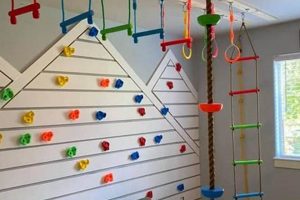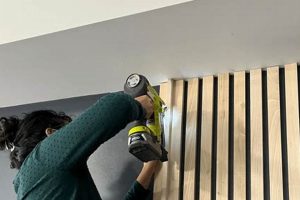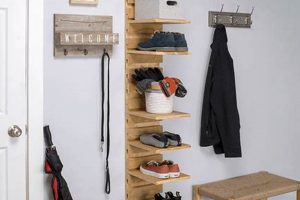A constructed imitation of a brick surface, often applied to interior walls, provides an aesthetic alternative to genuine masonry. These simulated brick finishes are typically achieved through various techniques, including the application of brick veneer, panels, or textured treatments directly onto an existing wall structure. For instance, a homeowner might utilize lightweight brick veneer adhered to drywall to replicate the appearance of a traditional brick wall.
The appeal of creating artificial brick surfaces stems from several factors. Such projects offer a cost-effective means of achieving a desired aesthetic compared to installing actual brick. Furthermore, they present a relatively straightforward solution for enhancing the visual appeal of a space without requiring extensive structural modifications. Historically, these methods have been utilized to evoke a sense of rustic charm or urban sophistication in interior design.
The subsequent sections will detail the specific materials, tools, and step-by-step procedures involved in successfully creating a simulated brick finish. These will encompass considerations for surface preparation, material selection, application techniques, and finishing touches necessary to achieve a realistic and durable result.
Essential Considerations for Simulated Brick Surfaces
Achieving a convincing and lasting simulated brick effect necessitates careful planning and execution. The following guidelines provide critical insights into key aspects of the process.
Tip 1: Surface Preparation is Paramount: Thoroughly clean and prime the substrate to ensure optimal adhesion. Remove any existing paint, wallpaper, or debris that could compromise the bond between the wall and the faux brick material.
Tip 2: Material Selection Influences Realism: Consider the texture, color, and size variations within the chosen faux brick product. Opt for materials that closely mimic the appearance of authentic brick for a more believable outcome. For example, a product with subtle color shifts and irregular edges will appear more realistic than a uniformly colored, perfectly rectangular option.
Tip 3: Staggered Patterns Enhance Authenticity: Employ a staggered brick pattern during installation to replicate the typical layout found in traditional brickwork. Avoid a grid-like arrangement, as this will detract from the realistic appearance.
Tip 4: Mortar Detailing Adds Depth: Pay close attention to the mortar joints. Use appropriate tools and techniques to create recessed mortar lines that provide depth and dimension. Select a mortar color that complements the faux brick to enhance the overall aesthetic.
Tip 5: Sealing for Durability and Protection: Apply a sealant to the finished faux brick surface to protect it from moisture, stains, and damage. This is especially important in areas prone to humidity or spills.
Tip 6: Consider Lighting Effects: Evaluate how lighting will interact with the faux brick surface. Strategic placement of lighting can accentuate the texture and color variations, further enhancing the realism of the installation.
By adhering to these recommendations, individuals can significantly improve the outcome of their faux brick wall projects, resulting in a visually appealing and durable finish.
The subsequent discussion will explore the common challenges encountered during faux brick wall installations and offer practical solutions to overcome them.
1. Material selection
The selection of materials directly dictates the aesthetic outcome, installation complexity, and overall durability of a simulated brick facade. For example, opting for individual thin brick veneer necessitates precise cutting and alignment, demanding more labor and specialized tools than pre-fabricated panels. Conversely, choosing a textured paint or joint compound technique offers a budget-friendly alternative but may compromise the realism of the brick appearance. The effect on visual authenticity and project cost are directly related to the primary material choices.
Furthermore, the material selection influences the structural considerations of the project. Heavier materials, such as real brick veneer, may require reinforcing the existing wall structure to support the added weight. Lighter materials, like foam panels, reduce the need for such reinforcement but might be more susceptible to damage and require more careful handling during installation. These materials vary in ease of cut and placement, demanding appropriate tools and expertise for proper installation. Selecting the most appropriate material also influences maintenance needs and the expected lifespan of the constructed surface.
In conclusion, material selection represents a foundational decision point in any simulated brick wall project. Understanding the trade-offs between cost, ease of installation, aesthetic quality, and structural requirements is critical to achieving a satisfactory and enduring result. Ignoring these considerations can lead to premature failure, aesthetic dissatisfaction, or unnecessary expenditure. The success of a faux brick installation is inherently tied to the informed choices made during material procurement.
2. Surface preparation
Surface preparation constitutes a critical, non-negotiable stage in the successful implementation of any simulated brick wall project. Improperly prepared surfaces directly compromise the adhesion of applied materials, leading to premature detachment, cracking, or general failure of the faux brick facade. For example, applying brick veneer to a wall with loose paint or residual wallpaper prevents a secure bond, invariably resulting in detachment within a relatively short timeframe. Thorough cleaning, sanding to create a textured surface, and the application of a suitable primer are essential steps to ensure the long-term integrity of the simulated brick finish. The absence of proper surface preparation negates the investment of time and resources allocated to subsequent stages.
Consider the scenario of a homeowner attempting to apply faux brick panels directly over a glossy, unprimed wall. The smooth, non-porous surface hinders the adhesive’s ability to grip effectively. Over time, temperature fluctuations and minor vibrations within the building structure will weaken the bond, causing the panels to loosen and potentially fall. This situation highlights the practical significance of understanding the cause-and-effect relationship between surface condition and the longevity of the simulated brick. A stable, properly prepared surface is the fundamental foundation upon which the entire project rests.
In summary, surface preparation is not merely a preliminary step but an integral component that directly determines the success or failure of a simulated brick wall project. Overlooking this stage introduces significant risk and compromises the durability and aesthetic appeal of the final result. Addressing challenges such as uneven surfaces, moisture problems, and existing wall imperfections is paramount to creating a lasting, visually pleasing faux brick installation, effectively linking to the broader theme of meticulous execution for optimal results.
3. Adhesive application
Adhesive application represents a critical stage in the successful creation of a simulated brick wall. The choice of adhesive, its proper application, and its compatibility with both the substrate and the faux brick material directly influence the structural integrity and longevity of the finished surface. Failure to adhere to proper techniques can result in detachment, instability, and ultimately, the failure of the entire project.
- Adhesive Selection and Compatibility
The selection of an appropriate adhesive is paramount. Different faux brick materials, such as thin brick veneer, panels composed of various polymers, or even textured compounds, require specific adhesives designed for their particular properties. For example, a heavy-duty construction adhesive may be suitable for adhering brick veneer to drywall, while a lighter-weight adhesive may be more appropriate for foam panels. Compatibility between the adhesive and both the faux brick material and the underlying substrate must be verified to ensure a lasting bond. Using an incompatible adhesive can lead to poor adhesion, chemical reactions that degrade the materials, or premature failure of the installation.
- Surface Preparation and Adhesive Bond
The effectiveness of any adhesive is intrinsically linked to proper surface preparation. A clean, dry, and properly primed surface provides the optimal foundation for adhesive bonding. Contaminants such as dust, grease, or loose paint can impede adhesion and reduce the bond strength. Priming the substrate with a compatible primer enhances the adhesive’s ability to penetrate the surface and create a strong, lasting connection. The application of the adhesive itself must also be consistent and uniform to ensure even distribution of the bonding force. Uneven application can create weak spots and increase the risk of detachment.
- Application Techniques and Environmental Conditions
Adhesive application techniques vary depending on the type of adhesive and the faux brick material being used. Some adhesives are applied directly to the substrate, while others are applied to the back of the faux brick material. The manufacturer’s instructions should always be followed meticulously to ensure proper application. Environmental conditions, such as temperature and humidity, can also affect the adhesive’s performance. Extreme temperatures or high humidity can either accelerate or retard the curing process, potentially compromising the bond strength. Working within the recommended temperature and humidity ranges is crucial for achieving optimal results.
- Curing Time and Load-Bearing Capacity
Adhesives require a specific curing time to achieve their full bond strength. During this period, the faux brick installation should be supported to prevent shifting or movement that could weaken the adhesive bond. The load-bearing capacity of the adhesive should also be considered, especially when installing heavier faux brick materials. Using an adhesive with insufficient load-bearing capacity can lead to structural instability and potential failure. Understanding the adhesive’s specifications and limitations is essential for ensuring a safe and durable faux brick wall installation.
In summary, adhesive application is a multifaceted process that demands careful consideration of material compatibility, surface preparation, environmental conditions, and load-bearing capacity. Deviations from established best practices can compromise the integrity of the simulated brick wall, leading to aesthetic imperfections, structural instability, and costly repairs. The success of any faux brick project hinges on a thorough understanding and meticulous execution of proper adhesive application techniques.
4. Mortar technique
Mortar technique constitutes a pivotal element in the creation of a convincing imitation brick surface. The method employed to simulate mortar joints directly influences the perceived realism, depth, and overall aesthetic appeal of the constructed facade. Proper execution of the mortar technique elevates the imitation from a rudimentary application to a sophisticated architectural detail.
- Mortar Color Selection
The selection of mortar color significantly impacts the overall visual impression. A contrasting mortar color accentuates the individual faux bricks, creating a defined and bold appearance. Conversely, a mortar color closely matching the brick tones provides a more subtle and blended aesthetic. The desired effect should be determined prior to application, taking into account the style of brick being simulated and the overall design intent. For instance, a dark gray mortar paired with red brick evokes a traditional, industrial aesthetic, while a light beige mortar with tumbled brick suggests a more rustic and aged appearance. Incorrect color choices will diminish the authentic impression.
- Joint Profile and Depth
The profile and depth of the simulated mortar joints contribute substantially to the three-dimensional quality of the brick facade. A recessed joint profile, achieved through tooling or specialized application methods, creates shadows that enhance the perceived depth and texture. The depth of the recess should be consistent throughout the wall surface to maintain a uniform and professional appearance. Conversely, a flush or overly deep joint profile can appear unnatural and detract from the overall realism. Consistent attention to the tooling process is crucial for a refined result.
- Application Method and Consistency
Various application methods can be employed to simulate mortar joints, ranging from traditional grouting techniques to the use of textured compounds and specialized tools. Regardless of the chosen method, consistency in application is paramount. Uneven mortar lines, variations in joint width, and inconsistent texture undermine the authentic appearance of the simulated brick. Techniques such as using painter’s tape to define joint lines and employing a consistent pressure when tooling the mortar can help achieve a uniform and professional finish. Practice and careful attention to detail are essential for mastering the application process.
- Mortar Joint Texture
The texture of the simulated mortar joints adds another layer of realism to the faux brick wall. Smooth, uniform mortar joints can appear too artificial, particularly when paired with highly textured faux bricks. Introducing subtle texture to the mortar surface, such as lightly stippling or scoring the mortar before it fully dries, can mimic the imperfections found in authentic brickwork. The chosen texture should complement the overall aesthetic of the wall and be applied consistently across the entire surface to achieve a cohesive and believable result.
These diverse aspects of mortar technique directly impact the success of any simulated brick wall undertaking. Each element plays a crucial role in creating a realistic and visually appealing finish. Proficiency in these techniques elevates the final product, transforming a basic imitation into a compelling architectural feature. Consistent detail in each area will increase the quality, longivity, and realism to the surface.
5. Sealer protection
The application of a sealant represents a critical final step in the construction of simulated brick walls, providing essential protection against environmental factors and prolonging the aesthetic appeal and structural integrity of the installation. Neglecting this stage exposes the faux brick and mortar to moisture damage, staining, and premature wear, diminishing the intended visual impact and potentially necessitating costly repairs.
- Moisture Resistance and Prevention of Damage
Sealers create a hydrophobic barrier, repelling water and preventing it from penetrating the faux brick and mortar. This is particularly crucial in areas prone to humidity or direct water exposure, such as bathrooms or kitchens. The ingress of moisture can lead to efflorescence (the migration of salts to the surface), cracking due to freeze-thaw cycles, and the growth of mold and mildew. By inhibiting moisture penetration, sealers significantly reduce the risk of these forms of damage. For instance, a silicone-based sealant applied to a faux brick wall in a shower can effectively prevent water damage and maintain its appearance for an extended period.
- Stain Resistance and Ease of Maintenance
Sealants also provide a protective layer that resists staining from common household substances, such as oils, spills, and cleaning agents. The non-porous surface created by the sealant makes it easier to clean the faux brick wall and maintain its original appearance. Without sealant protection, porous faux brick and mortar can readily absorb stains, making them difficult or impossible to remove. An acrylic-based sealant, for example, can effectively protect a faux brick backsplash in a kitchen from food stains and grease splatters, simplifying cleaning and preserving its aesthetic appeal.
- UV Protection and Color Retention
Some sealants contain UV inhibitors that protect the faux brick and mortar from fading or discoloration caused by prolonged exposure to sunlight. This is especially important for faux brick walls located in areas with high sun exposure, such as sunrooms or exterior applications. UV rays can break down the pigments in the faux brick and mortar, causing them to fade over time. Sealants with UV protection help maintain the original color and vibrancy of the faux brick, ensuring a long-lasting and aesthetically pleasing finish. A UV-resistant polyurethane sealant applied to an exterior faux brick wall can prevent fading and maintain its color integrity for several years.
- Enhanced Durability and Longevity
Beyond immediate protection against moisture and staining, sealants contribute to the overall durability and longevity of the faux brick wall. By preventing the degradation of the faux brick and mortar, sealants extend the lifespan of the installation and reduce the need for frequent repairs or replacements. This is particularly beneficial for high-traffic areas or applications where the faux brick wall is subject to wear and tear. A penetrating epoxy sealant, for example, can significantly increase the strength and durability of a faux brick floor, protecting it from abrasion and impact damage.
In essence, sealant protection is an indispensable component of any simulated brick wall project. These sealants provide aesthetic benefits such as maintaining color to physical protections against water damage and stains. By applying appropriate techniques, one can ensure that the installed facade will have a lasting beautiful result.
Frequently Asked Questions Regarding Simulated Brick Wall Construction
The following addresses common inquiries and concerns related to the planning, execution, and maintenance of artificial brick facades.
Question 1: What is the average lifespan of a simulated brick wall, and what factors influence its durability?
The typical lifespan varies considerably based on material selection, installation quality, and environmental conditions. Properly installed brick veneer with adequate sealing can last for decades indoors. However, exposure to moisture, extreme temperatures, or physical impact can significantly reduce its longevity. Regular cleaning and periodic resealing are crucial for maximizing durability.
Question 2: Are simulated brick walls suitable for all interior spaces, including bathrooms and kitchens?
While adaptable, suitability depends on material choice and preparation. Moisture-resistant materials, such as sealed brick veneer or certain types of faux brick panels, are necessary for bathrooms and kitchens. Proper ventilation and consistent maintenance are also critical to prevent moisture damage and maintain structural integrity.
Question 3: What are the primary cost considerations when planning a simulated brick wall project?
Cost factors encompass materials (faux brick, adhesive, grout/mortar, sealant), tools (cutting tools, levels, trowels), and labor (if professional installation is employed). Material selection significantly impacts the overall expense, with genuine brick veneer being generally more costly than faux brick panels or textured treatments. Budgeting should also account for unforeseen expenses and potential structural modifications.
Question 4: Can a simulated brick wall be installed over existing wall coverings, such as wallpaper or tile?
Direct installation over existing wall coverings is generally discouraged. Wallpaper and tile can compromise adhesion and potentially lead to detachment. Removal of existing coverings, followed by thorough surface preparation (cleaning, sanding, priming), is recommended to ensure a secure and lasting bond.
Question 5: How can a simulated brick wall be effectively cleaned and maintained to preserve its appearance?
Cleaning protocols depend on the material and sealant used. Generally, a mild soap and water solution applied with a soft cloth or sponge is sufficient for removing surface dirt and dust. Avoid abrasive cleaners or harsh chemicals, as these can damage the sealant and the faux brick itself. Periodic resealing is recommended to maintain moisture resistance and protect against staining.
Question 6: What are the potential challenges or complications that may arise during a simulated brick wall installation?
Potential challenges include uneven wall surfaces, difficulty cutting and fitting materials, ensuring proper adhesion, and achieving a realistic mortar joint appearance. Careful planning, accurate measurements, and adherence to best practices are essential for mitigating these complications. Seeking professional assistance may be advisable for complex installations or when encountering unforeseen structural issues.
In summary, the successful creation and maintenance of a faux brick wall requires a blend of informed decision-making, skillful execution, and consistent care. Thorough planning and informed material choices play a crucial role.
The subsequent section will address design considerations and stylistic options for implementing a faux brick accent wall.
Conclusion
The preceding exploration of “diy faux brick wall” construction has delineated critical factors governing the aesthetic and structural integrity of such projects. From material selection and surface preparation to adhesive application, mortar techniques, and sealant protection, each stage demands meticulous attention to detail. The long-term viability of a simulated brick facade is intrinsically linked to adherence to established best practices and a comprehensive understanding of the materials involved.
Successfully implementing a simulated brick wall necessitates a commitment to thorough planning and precise execution. Ignoring fundamental principles can lead to premature failure, aesthetic dissatisfaction, and avoidable expense. Therefore, individuals undertaking such projects should prioritize informed decision-making and diligent craftsmanship to achieve a durable and visually convincing result.






![Build a DIY Wheeled Patio Privacy Wall Screen [Easy!] The DIY Hub: Creative Crafts, Repairs & Life Hacks Build a DIY Wheeled Patio Privacy Wall Screen [Easy!] | The DIY Hub: Creative Crafts, Repairs & Life Hacks](https://craftingdiycenter.com/wp-content/uploads/2025/07/th-2201-300x200.jpg)
